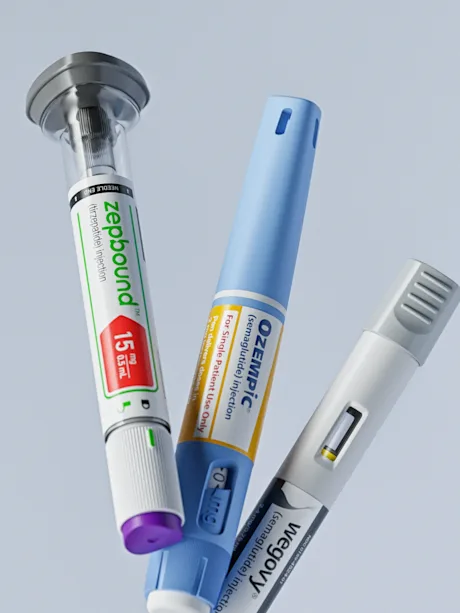Our Body Program combines GLP-1 medication with 1:1 personal coaching and 12 months of curriculum and support—all to help you lose weight and keep it off.
How do GLP-1 drugs work?
GLP-1s act like a hormone your body naturally makes to regulate blood sugar and can help support sustained weight loss.
Simple dosing
Take the GLP-1 as directed using a simple, self-injection pen.
Feel satisfied faster
GLP-1s talk directly to the part of your brain in charge of feeling full and satisfied—helping you regulate how much you eat.
Feel full longer
GLP-1s slow down how quickly food leaves your stomach—making you feel full faster.
Break the cycle
No more relying on willpower alone—GLP-1s use proven science to help your body find a new, lower weight to maintain.


Unlock your healthiest body yet
Promo: $99 first month, $145/month thereafter
Access to doctor-prescribed GLP-1s
Personal health coaching via video chats and messaging
Personalized weight loss plan
Insurance concierge to help navigate medication coverage
The Body Program cost excludes cost of GLP-1 medication
*You can take your test at any Quest location or purchase an at-home blood collection kit through Ro for an additional cost.If you live in a state where Quest is not available, we’ll automatically send you an at-home collection kit for no charge.
GLP-1 FAQs
What is GLP-1?
GLP-1 is the abbreviation for glucagon-like peptide 1, a hormone your body naturally makes. It has receptors all over the body, but especially in the gut and the brain.
Here is what GLP-1s are.
When you eat a meal, your body’s natural GLP-1 tells your pancreas to release insulin and hold back on releasing glucagon—helping your body better process any sugars you’ve consumed.
In the meantime, other GLP-1 receptors in your gut slow down how quickly your stomach empties, making you feel full faster. And GLP-1 also binds to receptors in the parts of your brain in charge of feeling full and satisfied. The result is that you consume fewer calories, ultimately leading to sustained weight loss.
What are GLP-1 drugs?
GLP-1 drugs are a class of medications called GLP-1 analogs. Technically, they’re called glucagon-like peptide 1 receptor agonists, but we like calling them “GLP-1s” for short.
They act like the natural hormone GLP-1, binding to its receptors in different parts of the body and causing the same effects—leading to sustained weight loss and improved response to blood glucose.
GLP-1 drugs are an exciting approach to weight loss, and are one part of how the Ro Body Program supports your weight loss goals.
Here is what GLP-1s are.
Do you prescribe GLP-1s for weight loss?
Some GLP-1s, like Wegovy (semaglutide) injection, are specifically FDA-approved for weight loss. Others, like Ozempic (semaglutide) injection, are approved for the treatment of certain symptoms and risks of type 2 diabetes, but may be prescribed off-label for weight loss.
As part of the Ro body program Ro-affiliated healthcare professionals have the discretion to prescribe a medication off-label if they believe it is an appropriate course of treatment for a particular patient.
How can GLP-1s help with weight loss? They are like a natural hormone your body uses to regulate blood sugar and appetite—key steps in resetting your biological set point to help you maintain a new, lower weight.
Here is how GLP-1s can be used for weight loss.
See if GLP-1s are right for you here.
What is a typical GLP-1 dose?
For most GLP-1s, dosing starts out low, then gradually increases over the first few months until a steady dose is reached. If prescribed, your Ro-affiliated provider will work with you to find the schedule and dosing that’s right for you.
How do you take GLP-1 drugs?
GLP-1s come in a prefilled injection pen that makes it easy to take your prescribed dose. If prescribed, you (or someone in your household) will administer the injection under the skin of your stomach, thigh, or arm once a week.
While a routine injection may sound intimidating, the GLP-1 pens use a tiny needle designed to minimize discomfort. You’ll also receive clear instructions on using the injection pen, and your Ro-affiliated provider can offer additional advice.
How much do GLP-1 weight loss drugs cost?
The cost of GLP-1 medications can be high.
So understanding, how you can get GLP-1s covered by insurance is an important consideration.
You can consider us at the Ro Body program your insurance concierge.
Our partners will work directly with your insurance provider to help with the process of determining coverage for your GLP-1 medication, which is paid for separately from the Body Program. Ro does not accept insurance for the Body Program, which is cash pay only. At this time, those with any form of government healthcare coverage (including programs such as Medicare, Medicaid or TRICARE), whether primary or secondary, are not eligible for the Ro Body Program. These plans typically do not cover the type of medication the Ro Body Program may prescribe. Unfortunately, this means that those on Medicare or eligible for Medicare cannot join the Ro Body Program.
Here is pricing for Ro's Body Program.
Will GLP-1s interact with any medications?
Because GLP-1s affect your digestion and blood sugar, combining them with other medications that do the same things may increase your risk of side effects. These include:
Medications that lower blood sugar (blood glucose), such as insulin, metformin, and sulfonylureas.
Medications that speed up or slow down your digestion, such as metoclopramide (Reglan), erythromycin, opioids, tricyclic antidepressants, and others.
What are the most common GLP-1 side effects?
All medications carry a risk of potential side effects. Any side effects of GLP-1s are typically mild and often improve within the first few weeks of treatment. When they occur, it’s usually when doses are increased, then tend to improve once a steady dose is reached. Some of the most common side effects include:
Nausea
Vomiting
Upset stomach
Stomach pains
Constipation
Diarrhea
Heartburn
Acid reflux
Belching and gas
Dizziness
Headaches
Fatigue
More severe side effects are uncommon but possible. Serious side effects include:
Thyroid cancer—The FDA has issued its most serious warning (called a BOXED WARNING) that GLP-1s may be associated with a type of thyroid cancer called medullary thyroid carcinoma. So far, this side effect has primarily been seen in laboratory studies using rodents, so the risk to humans has not been determined.
Pancreatitis
Gallbladder disease
Rapid heartbeat
Severe allergy (hypersensitivity)
Low blood sugar
Vision problems (diabetic retinopathy)
Kidney disease
Suicidal thoughts or behaviors
Who shouldn’t take a GLP-1?
GLP-1s aren’t for everyone. You shouldn’t take a GLP-1 if you have any of the following risk factors:
Personal or family history of medullary thyroid carcinoma
History of multiple endocrine neoplasia syndrome type 2 (MEN2)
Pregnant, possibly pregnant, or planning to get pregnant in the next 3 months; this applies to both men and women
Breastfeeding
History of hypersensitivity to semaglutide or other GLP-1 medications
History of pancreatitis
History of delayed gastric emptying or gastroparesis
History of gallbladder disease or bile duct disease
History of suicidal ideation or history of suicide attempts
History of tachycardia or atrial fibrillation
Type 1 diabetes
History of impaired kidney function
Diabetic retinopathy complications due to type 2 diabetes




